
The girdled wrasse, Notolabrus cinctus, is a species of wrasse native to the waters around the South Island and southeastern North Island of New Zealand, including the Chatham Islands and Snares Islands, where it can be found at depths from 15 to 91 m. The males of this species can reach 29.9 cm (11.8 in) in standard length, while the females only reach 29.1 cm (11.5 in). There are two colour phases with older fish developing a large, dusky belt around the body. This is not associated with changing sex which happens about three years after the development of the belt. They feed on molluscs and small crustacea. They occur on rocky reefs, where they are common.
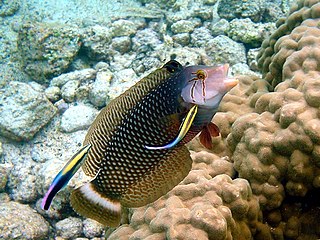
Novaculichthys taeniourus, also known as the rockmover wrasse, carpet wrasse, dragon wrasse, bar-cheeked wrasse, olive-scribbled wrasse or reindeer wrasse, is a species of wrasse mainly found in coral reefs and lagoons in the Indo-Pacific region. These include habitats in the Gulf of California to Panama; tropical Pacific Ocean islands including Hawaii; the Philippines, Indonesia and Australia; and the Indian Ocean to the east coast of Africa. The common name, "rockmover wrasse", comes from their behavior of upending small stones and reef fragments in search of prey. This species is the only known member of its genus.

The eight-lined wrasse is a species of marine ray-finned fish, a wrasse from the family Labridae, which is native to the Indian and Pacific Oceans. It occurs on coral reefs at depths from 2 to 50 m, preferring to shelter in niches and caves. It can also be found in the aquarium trade.
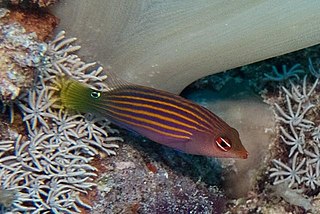
The six-line wrasse is a species of marine ray-finned fish from the family Labridae which has a wide Indo-Pacific distribution. This species is associated with coral reefs and can be found in the aquarium trade.
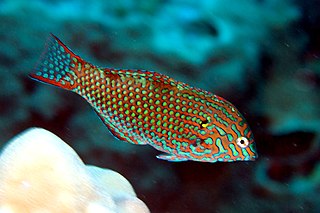
Macropharyngodon meleagris, the black-spotted wrasse, Eastern leopard wrasse or reticulated wrasse, is a species of ray-finned fish from the family Labridae, the wrasses. This species is native to the eastern Indian Ocean and the Pacific Ocean. It lives on coral reefs at depths of from the surface to 30 metres (98 ft). This species can reach a length of 15 centimetres (5.9 in) SL. It can also be found in the aquarium trade. Juveniles display different color patterns than adults with dominating light colors and eyespots blending in with soft coral habitats and potentially avoiding predation.

The slingjaw wrasse is a species of wrasse from the family Labridae which is native to the tropical waters of the Indo-Pacific where it occurs around coral reefs. This species is of minor importance to local commercial fisheries and can be found in the aquarium trade. Relatively mundane at first glance, this fish is notable for its highly protrusible jaws.

The inscribed wrasse is a species of marine ray-finned fish from the family Labridae, the wrasses. It is found in the southwestern Pacific Ocean.
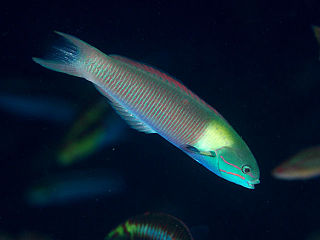
Thalassoma amblycephalum, the blunt-headed wrasse, blue-headed wrasse, blue-headed zoe, moon wrasse, paddle-fin wrasse or two-tone wrasse, is a species of wrasse native to the Indian Ocean and the western Pacific Ocean. It is a reef inhabitant, being found in schools at depths from 1 to 15 m. This species can reach 16 cm (6.3 in) in standard length. It can also be found in the aquarium trade.
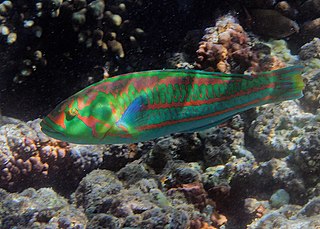
The surge wrasse, also known as the green-blocked wrasse, purple wrasse or red and green wrasse, is a species of wrasse native to the southeast Atlantic Ocean through the Indian and Pacific Oceans, where it inhabits reefs and rocky coastlines in areas of heavy wave action at depths from the surface to 10 m (33 ft). This species is of minor importance to local commercial fisheries, is popular as a game fish, and can be found in the aquarium trade.
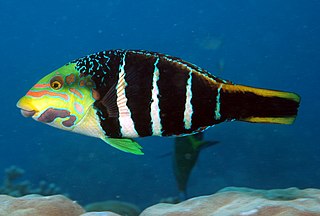
The barred thicklip wrasse, Hemigymnus fasciatus, is a species of fish belonging to the wrasse family, native from the Indo-Pacific.

The creole wrasse is a species of wrasse native to the western Atlantic Ocean.

The snakeskin wrasse, also known as the slender parrotfish or slender wrasse, is a species of wrasse native to the coastal waters of southern Australia. It inhabits rocky reefs down to about 17 m (56 ft). This species grows to a standard length of 12.4 cm (4.9 in). This species is the only known member of its genus.

Macropharyngodon is a genus of wrasses native to the Indian and Pacific Oceans.

The seagrass wrasse, Novaculoides macrolepidotus, is a species of wrasse native to the Indian Ocean and the western Pacific Ocean. It can be found in lagoons and mangrove forests in seagrass beds or on sandy areas with plentiful algal growth. It occurs at depths from the surface to 10 m (33 ft). This species grows to 16 cm (6.3 in) in total length. It can be found in the aquarium trade. This species is the only known member of its genus. The juveniles and smaller adults of this species are Batesian mimics of the venomous waspfish in the genus Ablabys. When threatened, these fish dive headfirst into the sea grass or sea weed beds they inhabit.

The chiseltooth wrasse is a species of marine ray-finned fish, a wrasse from the family Labridae. It is native to the Indian Ocean and the western Pacific Ocean. It is an inhabitant of coral reefs and can be found at depths from 3 to 60 m, though rarely deeper than 40 m (130 ft). This species grows to 30 cm (12 in) in total length. It is of minor importance to local commercial fisheries and can be found in the aquarium trade. P. moluccanus is the only known member of its genus.

Macropharyngodon geoffroy, also known as the Geoffroy's wrasse, is a member of the wrasse family endemic to the Hawaiian Islands. It occasionally makes its way into the aquarium trade. It grows to a length of 13 cm (5.1 in). This benthopelagic species occurs in areas of mixed sand, rubble, and coral on seaward reefs where it feeds mostly on molluscs, especially prosobranch gastropods) and foraminiferans. Macropharyngodon geoffroy is the type species of the genus Macropharyngodon.

Macropharyngodon negrosensis, the yellow-spotted wrasse, black Leopard-wrasse or black Wrasse, is a species of marine ray-finned fish from the family Labridae, the wrasses. The basic colour of this species is blackish, with the scales in males edged in pale green, or marked with small, pale spots in females. Both sexes have black anal and pelvic fins, while the caudal fin is contrastingly pale although the males have blackish lobes. It distribution extends from the Andaman Sea and Christmas Island to the Philippines and Samoa, extending north to the Ryukyu Islands and south to northern Australia. This species is found in lagoon and seaward reefs where there are areas of mixed sand and coral. The juveniles are transported by currents away from their normal breeding range. These fish are frequently encountered in pairs or small loose groups, normally close to the bottom. When approached, they react by moving up and down in an distinctive manner which may confuse a potential predator. Its diet consists of small benthic animals.
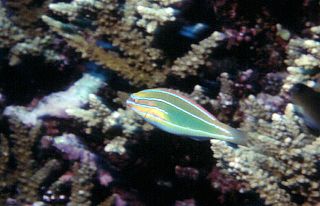
Stethojulis trilineata, also known as the blue-ribbon wrasse, red shouldered rainbow-fish, scarlet-banded rainbowfish, three-blueline wrasse, three-lined rainbowfish or three-lined wrasse, is a species of marine ray-finned fish, a wrasse from the family Labridae. It is found in the Indo-Pacific region where it is associated with reefs.

Halichoeres prosopeion, commonly called the twotone wrasse, half-grey wrasse or zig-zag wrasse, is a fish species in the wrasse family native to the western Pacific Ocean.

Halichoeres scapularis, commonly called the Zigzag wrasse , is a fish species in the wrasse family native from the Indo-West Pacific.




















